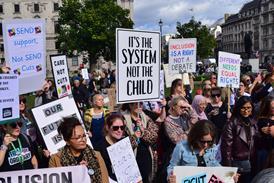Callery: PI solicitors still ensnared in fog
District Judge Jeremy Cochrane reflects on an opportunity missed in Callery
Much of life comprises a series of expectations.
Many are fulfilled, but not all.
For instance, the performance of a favourite opera with substitutes in the leading roles; perhaps many honeymoons - and the decision of the House of Lords in Callery v Gray [2002] UKHL 28, [2002] All ER (D) 233 (Jun), (2002) LTL June 27.
The personal injury (PI) claims industry has been hoping for many months that once the matter was considered by the Lords, unequivocal guidance would be forthcoming concerning the level of success fees, cost of after-the-event (ATE) insurance, and the appropriate stage at which such insurance might be purchased.
Then there would be the potential for reduction of further litigation on the subject.
Callery v Gray came about as a result of a road traffic accident on 2 April 2000.
Mr Callery was a passenger in a car being driven by a Mr Wilson when a vehicle driven by Mr Gray ran into its side.
Mr Callery sustained a minor injury, and swiftly instructed solicitors, signing a conditional fee agreement (CFA) on 28 April, the success fee being 60%.
On 4 May 2000, the solicitors wrote to the third-party driver, and on the same date Mr Callery took out ATE insurance at a total cost including tax of 367.50.
Liability was admitted by letter of 19 May.
Following a medical report being obtained, the claimant's solicitors made an offer under the Civil Procedure Rules 1998 (CPR) part 36 of 3,010 plus costs, and this was countered by an offer of 1,200.
The claim settled in August for 1,500, so it appears that the insurers' calculation of value may have been closer to what was about right.
As has become commonplace since April 1999, the matter of costs caused greater problems than the claim itself, the claimant arguing for his 60%, and in the CPR rule 44.12A costs-only proceedings before the district judge this was reduced to 40%, falling further to 20% when the matter reached the Court of Appeal.
The ATE premium provoked even greater anxiety and excitement, with the defendant's advisers arguing that it was inappropriate for insurance to be purchased before the attitude of the alleged tortfeasor was known, but they lost before the circuit judge and in the Court of Appeal.
Type of playing field
It was hoped the House of Lords would recognise the importance of these matters and react in a way to enable creation of, if not a level playing field, at least one where it was possible to see one end from the other.
However, their Lordships by a majority of four to one decided the matter was not really one for them.
Lord Bingham of Cornhill remarked on the obvious force in the appellant's contention that even the 20% success uplift provided a generous level of reward for Mr Callery's solicitors, and given the minuscule risk of failure which his claim apparently presented, that it would have been reasonable to await a reply from Mr Gray before obtaining ATE insurance cover.
What might reasonably be interpreted as disquiet was also obvious in the speeches of Lord Hoffman and Lord Hope of Craighead, who categorised the claimant's exposure to risk as being 'at the worst, minimal'.
Nonetheless, the House of Lords emphasised that responsibility for monitoring and controlling the developing practice in the field of conditional fees lies with the Court of Appeal.
That being so, the Lords would not interfere with its decision.
Lord Scott of Foscote dissented, his speech including a detailed analysis of CFAs, together with careful explanation of the fact that the costs of each case are to be quantified for the claim in question and on the nature of the particular claim.
That being so, a procedure by that side of the industry concerned with pursuing claims of standardised uplifts could not be applied.
Lord Hoffman agreed.
Lord Scott would have allowed the appeal to the extent of holding that the ATE insurance ought not to have been taken out until it was known how Mr Gray's insurers would react to the claim, and that the premium itself ought to have been tailored to the particular case.
It was he said 'a "block rating" case, not an individual assessment case', and that the Court of Appeal had been under the erroneous impression the premium had been calculated for the particular case.
So, after many months of preparation, consideration, and probably anxiety, the law remains as decided by the Court of Appeal in Callery v Gray, Russell v Pal Pak Corrugated Ltd [2001] EWCA Civ 1117, [2001] 3 All ER 833.
ATE insurance can be taken out at the outset, the premium being recoverable whether or not proceedings have been issued.
As for the amount of premium, there is little practical guidance.
Despite the careful and comprehensive report of Costs Judge John O'Hare, prepared for the assistance of the Court of Appeal after the initial appeal hearing, and considered in Callery v Gray (No 2) [ 2001] EWCA Civ 1246, [2001] 4 All ER 1, the only clear data of what it should cost is that available from the ATE insurers themselves.
This may not be considered helpful.
20% maximum, not norm
With regard to the level of success fee, since the Court of Appeal dealt with the case there has been a tendency for claimants to contend that a 20% uplift is the norm in PI claims of modest value.
That is not what was said.
The court said in its view 20% was the maximum which should be allowed in a 'modest and straightforward' claim, which had no special features to suggest that the claim might not be sound.
However, in arriving at this assessment it was recognised that the available data was limited.
Profit element
Although the CPR refer to 'the additional liability' which form of words includes the success fee and insurance premium, utilising uplift as a description for the profit costs may give the better flavour, but at the same time mislead.
Guideline costs figures already include uplift, being the aggregate of the former A and B figures.
A represented the cost of doing the work, and B the profit element, generally allowed at 50%, although adjustments were not uncommon.
Since the CPR came into force, 50% has become almost completely standardised, little if any effort being made to consider whether it is excessive or inadequate in the particular circumstances of the case.
Therefore, if a success fee of 20% is allowed on a guideline figure of, say 150, the profit increases to 80%.
With a success fee of 50%, profit rises to 125%.
The House of Lords made it clear that further consideration of the matters in question may have to take place, all speeches indicating significant unease, and one speech in particular that deserves to be read is that of Lord Hoffman, paragraphs 17 to 45.
It was hoped the Civil Justice Reforms would not produce anything to rival the former County Court Rules, order 17, rule 11.
They have.
District Judge Jeremy Cochrane sits at Derby County Court


























No comments yet